Ready to drive incremental growth with influencers?
If ditching the randomness of influencer campaigns and building a predictable, ROI-first influencer program sounds like a plan. Consider talking to our team!

Influencer Engagement
Learn practical ways to keep influencers posting consistently—through programs, calendars, challenges, and tiered incentives.
Contents
When brands start seeding products to influencers, it feels exciting. The brand gets talked about online without paying upfront, and posts start rolling in. But soon a problem shows up: most influencers post a few times, then stop. They forget about it or get busy with other brands.
To keep showing up on social media, the brand has to keep finding new people. This takes a lot of time and money.
The solution is to…
When people see a brand mentioned just once, it often feels like an ad. But when the same influencer talks about your brand again and again, it feels more real. Their followers start to think, “Okay, they must actually use this product.”
That repeated exposure makes your brand easier to remember and more trustworthy. The more often an audience hears about you from someone they already trust, the more likely they are to check you out or make a purchase.
Getting influencers to post more than once saves brands both time and money because it reduces the constant need to find new people.
Every new influencer requires outreach, product seeding, follow-ups, and negotiation—all of which take resources.
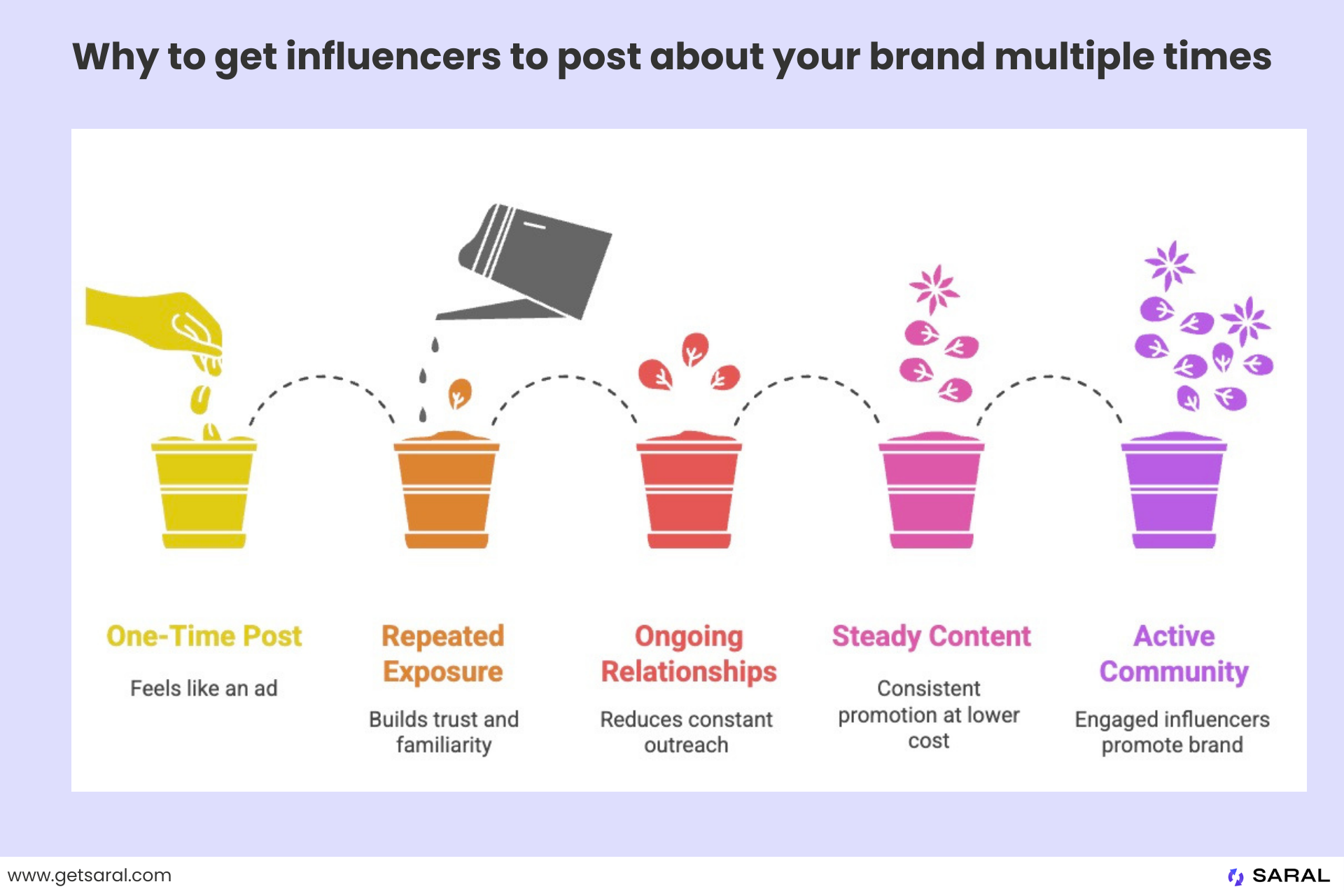
But when you focus on building ongoing relationships with influencers who already like your brand, that upfront effort pays off longer. You don’t have to restart the whole process each month. Instead of spending the budget on endless influencer gifting or flat-fee deals, you get steady content and promotion from the same trusted voices at a lower overall cost.
But how does one do that?
In this article, we’ll walk through practical ways to keep your influencer community active once you’ve already brought them on board.
Instead of only sending free products, invite the influencers who genuinely liked and posted about your product into a structured ambassador program.
Your gifting stage acts as a filter. The people you want are those who:
If they enjoyed the product enough to share for free, they’re strong candidates for a deeper partnership.
Kelsey Knight, Chief Commercial Officer at Slumberkins, echoed this approach. She noted that the best relationships start when creators show true alignment:
“When someone posts about us once, we pay attention to whether it was just content or if they truly engaged with our mission… If the alignment feels real, we bring them closer: sharing new launches early, inviting them into storytelling moments, or simply keeping the conversation going
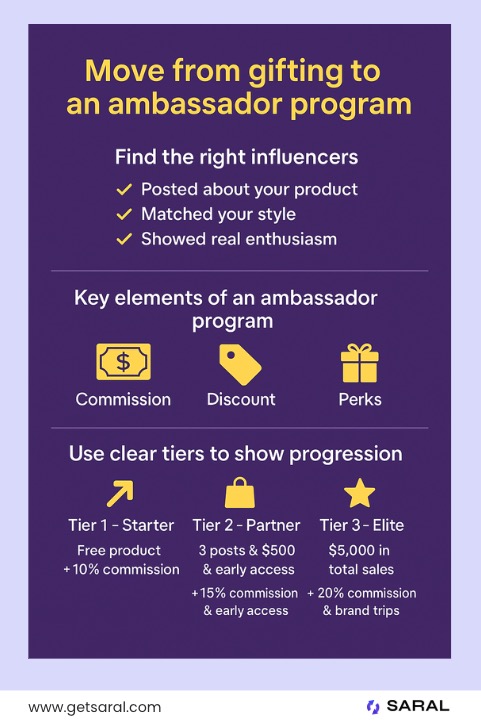
A good ambassador program usually gives influencers three things:
Start small with 10–15 ambassadors so you can give them proper attention. Stay in touch with regular updates, group chats, or a simple newsletter.
As the program grows, commissions and perks don’t have to stay the same for everyone. You can build a tiered system where ambassadors can earn better commission rates, bigger perks, or more exclusive opportunities as they get better results.
Share the path upfront so influencers can see how to progress. For example:
This approach works because people like clear goals and visible progress. It creates motivation to keep going.
After you’ve chosen your core ambassadors, bring them together. People stay more motivated when they feel part of a group instead of working alone. A dedicated space gives them that sense of community.
This could be a WhatsApp group, a Slack workspace, or a private Instagram chat.
Pura Vida's influencer program has a Facebook group exclusively for its influencers:

The platform matters less than the activity inside it. The goal is to create a place where influencers share wins, swap ideas, and celebrate each other’s posts. When they see their peers talking about your brand, they’re more likely to keep posting too.
Your role is to set the tone.
Start conversations, share campaign ideas, and highlight great content.
Make recognition a habit by calling out your top performers each month. Celebrate who drove the most sales, who came up with the most creative post, or who showed the most consistency. Public recognition fuels motivation and inspires others to step up.
Tools can make this easier. With SARAL, you can keep your influencer list in one place and send group updates, newsletters, and campaign opportunities without jumping between platforms.
A community without a guide quickly turns silent. It’s the same reason events need a host—someone to welcome people, start conversations, and keep the flow going.
That’s why it's wise to bring in a community manager for your influencers.
This doesn’t require a full-time hire. You can start small: 10–15 hours a week is enough. Some brands even elevate a “superfan” influencer into the role since they already understand the brand.
Their responsibilities should be clear and practical:
Pay them a flat fee with small bonuses tied to outcomes, like more posts per creator or steady participation in challenges. Done right, this role keeps your community lively and makes sure influencers don’t just join, but stay active month after month.
One of the biggest problems brands face with influencers is inconsistency. After the first post, it’s easy for creators to get busy with other partnerships and forget about your brand. For you, this means scrambling to get content live during key moments and losing out on consistent visibility.
An influencer activation calendar solves this.
It is a simple plan that lays out when and why your influencers should post. Instead of leaving it up to chance, you give them prompts across the year that tie into your marketing campaigns.
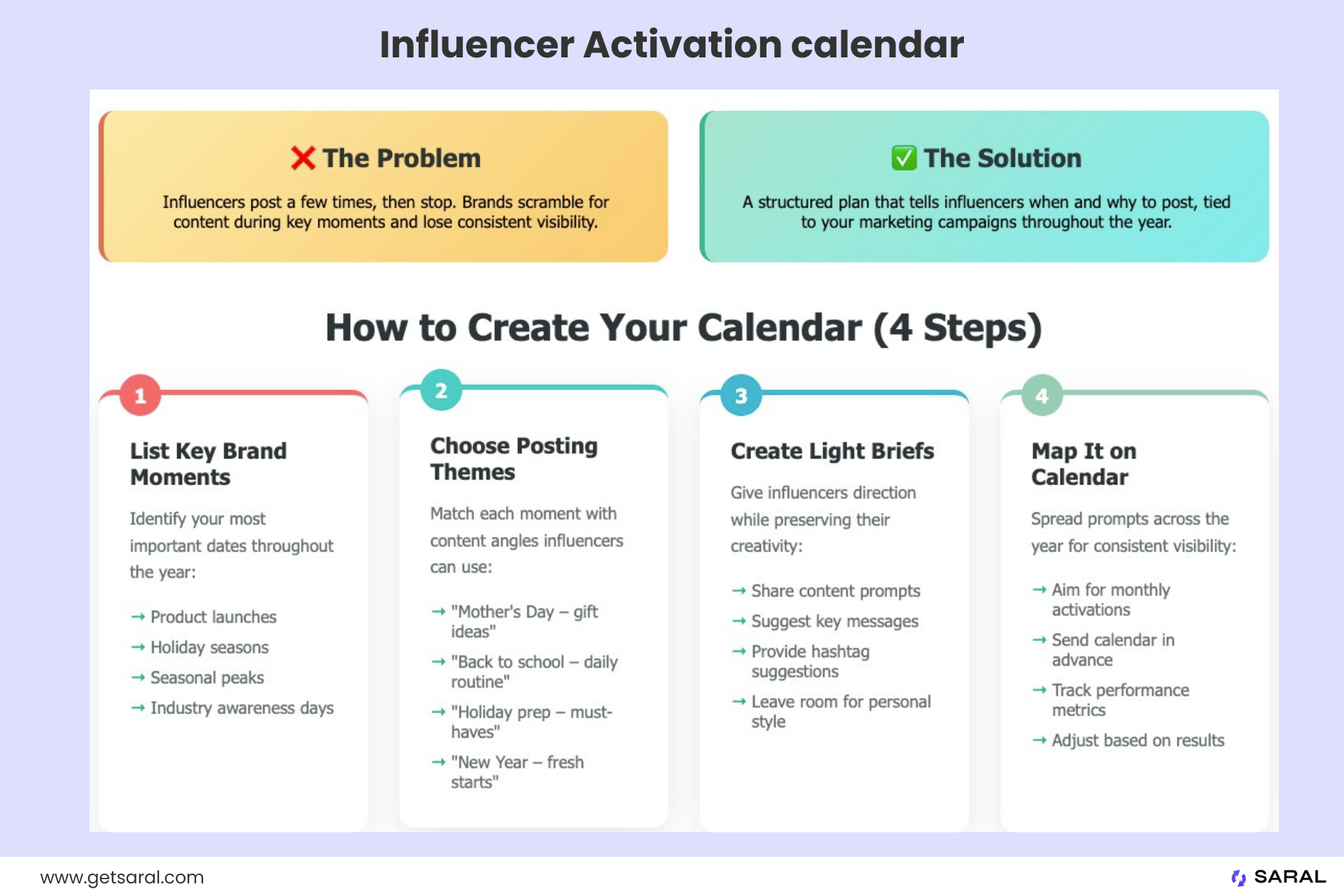
1. List key brand moments: Note down product launches, holidays, seasonal peaks, and any awareness days that fit your category.
2. Choose posting themes: Match each moment with a content angle influencers can use. Example: “Mother’s Day – gift ideas” or “Back to school – daily routine.”
3. Create a light brief: Share prompts for what the influencer can say in their posts. Give them a direction while leaving room for their creativity.
Kelsey Knight, Chief Commercial Officer at Slumberkins, also resonated with this idea. She shared:
“Instead of scripts, we give creators direction — story angles, examples of visuals that resonate, and photography tips. The goal isn’t to control their voice; it’s to make sure they feel supported and equipped so their creativity can shine
4. Map it on a calendar: Spread prompts across the year so your brand shows up regularly. Aim for at least one activation per month.
Send the calendar to influencers in advance so they can plan posts ahead of time. And don't forget to measure which prompts drove the most posts, engagement, and sales. Keep what works and adjust the rest.
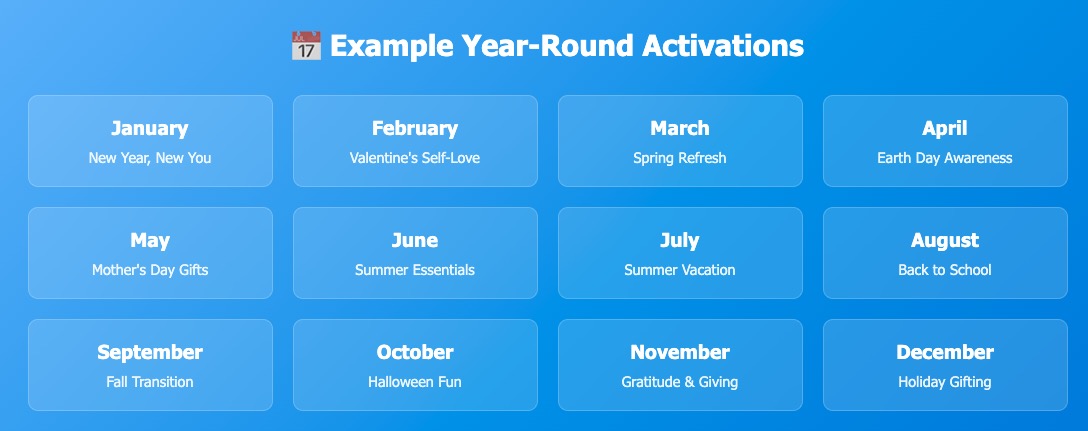
Even committed ambassadors sometimes lose focus if there’s nothing new to work toward. Monthly challenges give them a reason to post more often and stay active. They turn “I’ll post when I get to it” into a clear, time-bound goal.
How it works:
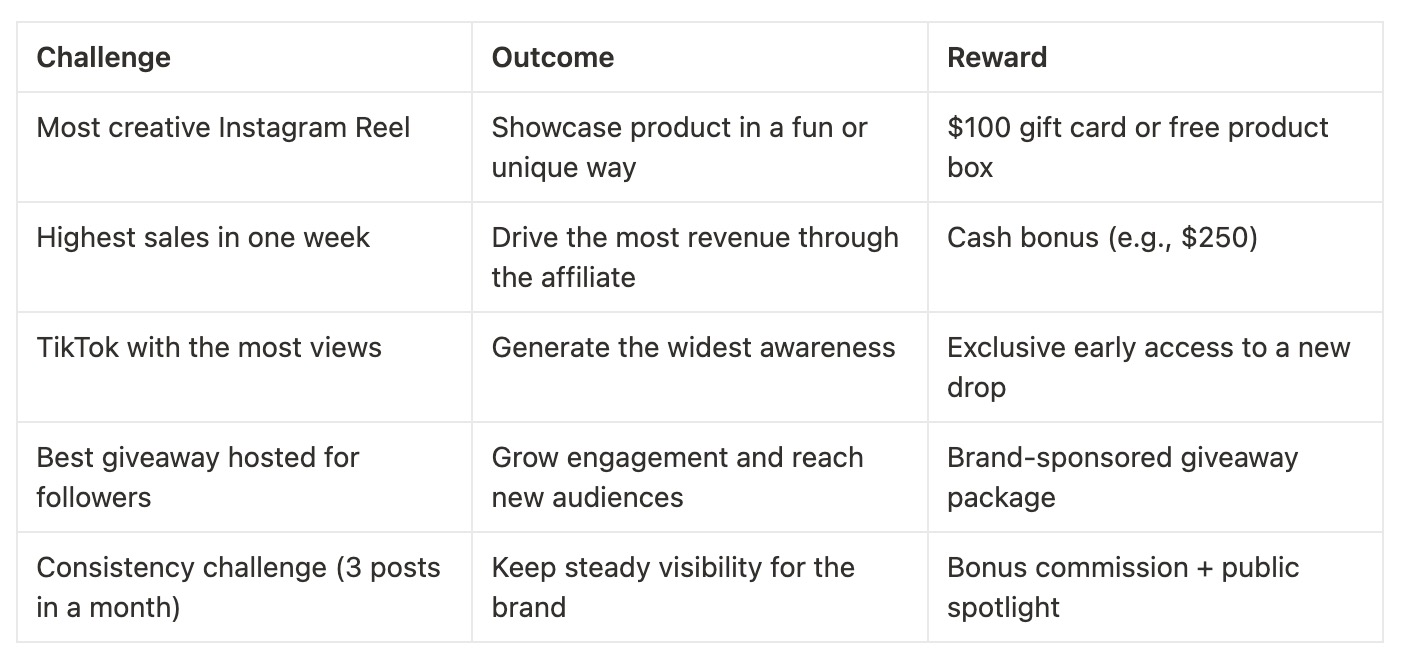
Keep the rules easy to understand and announce them in advance.
For example, Revolve promised free coffee for the rest of the year to ambassadors bringing in the most orders.

Share updates during the challenge so ambassadors know how they’re doing. At the end, spotlight the winners in your community group or newsletter. That recognition is just as motivating as the reward itself, because it shows their effort is noticed.
Over time, these challenges build a rhythm. Instead of one-off mentions, your influencers get used to talking about your brand every month in new and creative ways.
Most ambassador programs pay only for sales. That works for some creators, but it can frustrate others. An influencer might spend hours making a video that reaches 50,000 people, but if it doesn’t convert right away, they earn nothing. Over time, that can discourage quality content.
A smarter approach is to test incentives that reward awareness as well as sales. One option is a CPM-style payout, where creators are paid for views or reach.
For example, if your Facebook ads normally cost you $25 CPM, offering an influencer $15–20 CPM for the same reach could be more cost-effective and feel fairer to them.
You don’t need to overhaul your whole program overnight. Start with a small group of trusted ambassadors and test different models:
Kelsey highlighted how storytelling signals real influence:
“It’s easy to be impressed by a beautiful feed or a large follower count, but conversion usually comes from something deeper: storytelling. The creators who move the needle for us are the ones who talk openly about their parenting journey, show up on video, or explain why a product makes a difference in their daily life.”
Track results and compare them to your ad benchmarks. If an influencer can get you cheaper reach than Meta ads—and with more authenticity—you’ve found a scalable model.
Keeping influencers posting again and again isn’t about one trick. You need to layer the different strategies we discussed.
Executing all of it will be difficult if you are only using spreadsheets, manual tracking, or disconnected apps. That’s why having the right tool matters.
We built SARAL after working with brands and listening to what actually slows them down. Instead of adding features we think you’ll use, we focused on what works in the real world.
With SARAL, you can:
Book a demo to see how SARAL can help you put these ideas into action.
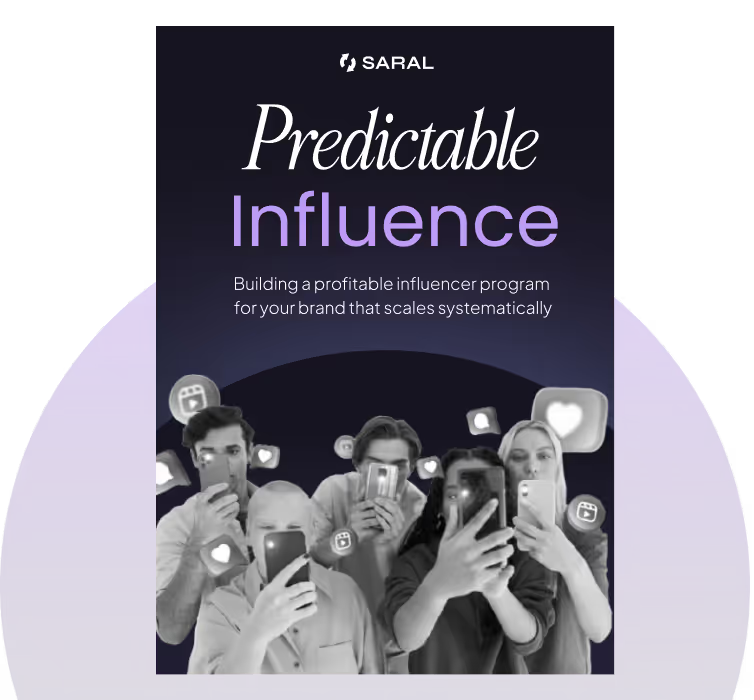
Sign up for a 7-day email course on the unique "Predictable Influence" strategy used by top brands like Grüns, Obvi, Tabs Chocolate.

If ditching the randomness of influencer campaigns and building a predictable, ROI-first influencer program sounds like a plan. Consider talking to our team!